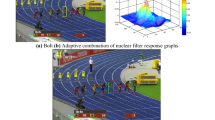Abstract
A dual-kernel-based tracking approach for visual target is proposed in this paper. The similarity between candidate and target model, and the contrast between candidate and its neighboring background are considered simultaneously when evaluating a target candidate. The similarity is measured by Bhattacharyya coefficient while the contrast is calculated with Jensen-Shannon divergence, and they are adaptively fused into a novel objective function. By maximizing the linear approximation of objective function, a dual-kernel target location-shift relation from current location to a new location is induced. According to the location-shift relation, the optimal target location can be recursively gained in the mean shift procedure. Experimental evaluations on several image sequences demonstrate that the proposed algorithm can gain more accurate target location and better identification power to false target, and it is also robust to deformation and partial occlusion.
Similar content being viewed by others
References
Comaniciu D, Ramesh V, Meer P. Kernel-based object tracking. IEEE Trans PAMI, 2003, 25: 564–577
Collins R T. Mean shift blob tracking through scale space. In: Proceedings of IEEE International Conference on Computer Vision and Pattern Recognition, Wisconsin, USA, 2003. 234–240
Fan J, Wu Y, Dai S. Discriminative spatial attention for robust tracking. In: Proceedings of European Conference on Computer Vision, 2010. 480–493
Yang C J, Duraiswami R, Davis L S. Efficient mean-shift tracking via a new similarity. In: Proceedings of IEEE International Conference on Computer Vision and Pattern Recognition, Beijing, China, 2005. 176–183
Yilmaz A. Object tracking by asymmetric kernel mean shift with automatic scale and orientation selection. In: Proceedings of IEEE International Conference on Computer Vision and Pattern Recognition, Minneapolis, USA, 2007. 1–6
Ning J F, Zhang L, Zhang D. Robust mean shift tracking with corrected background-weighted histogram. IET Comput Vis, 2011, http://www4.comp.polyu.edu.hk/cslzhang/papers.htm
Wren C R, Azarbayejani A, Darrell T, et al. Pfinder: real-time tracking of the human body. IEEE Trans PAMI, 1997, 19: 780–785
Stauffer C, Grimson W E L. Adaptive background mixture models for real-time tracking. In Proceedings of IEEE International Conference on Computer Vision and Pattern Recognition, Ft. Collins, CO, USA, 1999. 246–252
Hayman E, Eklundh J O. Statistical background subtraction for a mobile observer. In: Proceedings of IEEE International Conference on Computer Vision and Pattern Recognition, Wisconsin, USA, 2003. 67–74
Sidenbladh H, Black M J. Learning the statistics of people in images and video. Int J Comput Vis, 2003, 54: 181–207
Kim Z W. Real time object tracking based on dynamic feature grouping with background subtraction. In: Proceedings of IEEE International Conference on Computer Vision and Pattern Recognition, Anchorage, Alaska, USA, 2008. 1–8
Avidan S. Support vector tracking. IEEE Trans PAMI, 2004, 26: 1064–1072
Cuevas C, Garcia N. Tracking-based non-parametric background-foreground classification in a chromaticity gradient space. In: Proceedings of IEEE International Conference on Image Processing, Hong Kong, China, 2010. 845–848
Collins R, Liu Y. On-line selection of discriminative tracking features. In: Proceedings of IEEE Conference on Computer Vision, Nice, France, 2003. I: 346–352
Nguyen H, Smeulders A W M. Robust tracking using foreground-background texture discrimination. IJCV, 2006, 69: 277–293
Comaniciu D, Meer P. Mean shift: a robust approach toward feature space analysis. IEEE Trans PAMI, 2002, 24: 603–619
Fleuret F, Berclaz J, Lengagne R, et al. Multicamera people tracking with a probabilistic occupancy map. IEEE Trans PAMI, 2008, 30: 267–282
Lin J H. Divergence measures based on the Shannon entropy. IEEE Trans Inf Theory, 1991, 37: 145–151
Wang X L. Stable adaptive fuzzy control of nonlinear systems. IEEE Trans Fuzzy Syst, 1993, 1: 146–155
Maggio E, Cavallaro A. Hybrid particle filter and mean shift tracker with adaptive transition model. In: Proceedings of IEEE International Conference on Acoustics, Speech, and Signal Processing, Philadelphia, PA, USA, 2005
Author information
Authors and Affiliations
Corresponding author
Rights and permissions
About this article
Cite this article
Zhang, C., Jing, Z., Jin, B. et al. A dual-kernel-based tracking approach for visual target. Sci. China Inf. Sci. 55, 566–576 (2012). https://doi.org/10.1007/s11432-011-4543-x
Received:
Accepted:
Published:
Issue Date:
DOI: https://doi.org/10.1007/s11432-011-4543-x




